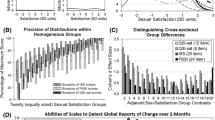Abstract
Although effeminacy is recognized to be a complex and important phenomenon, until now it has been only scantily studied, and has not been clearly defined or measured. In this paper, we review the literature and present an Effeminacy Rating Scale that quantifies the behavioral fragments comprising the overall clinical picture of effeminacy. We also present data obtained in a trial of the scale on a sample of 16 homosexual and 16 heterosexual males. The scale was found to have a high interrater reliability (0.93) and can therefore be used to study effeminacy quantitatively.
Similar content being viewed by others
References
Bakwin, H. (1968). Deviant gender-role behavior in children — relations to homosexuality.Pediatrics 41: 620–629.
Gough, H. G. (1952). Identifying psychological femininity.Educ. Psychol. Meas. 12: 427–439.
Gough, H. G. (1966). A cross-cultural analysis of the CPI femininity scale.J. Consult. Psychol. 30: 136–141.
Green, R. (1968). Childhood cross-gender identification.J. Nerv. Ment. Dis. 147: 500–509.
Green, R., and Money, J. (1960). Incongruous gender role: Non-genital manifestation in prepubertal boys.J. Nerv. Ment. Dis. 131: 160–168.
Green, R., and Money, J. (1961). Effeminacy in prepubertal boys.Pediatrics 27: 286–291.
Hays, W. L. (1963).Statistics for Psychologists Holt, Rinehart, and Winston, New York.
Holemon, E., and Winokur, G. (1965). Effeminate homosexuality: A disease of childhood.Am. J. Orthopsychiat. 35: 48–56.
Kinsey, A. C., Pomeroy, W. B., and Martin, C. E. (1948).Sexual Behavior in the Human Male Saunders, Philadelphia.
Lebowitz, P. S. (1972). Feminine behavior in boys: Aspects of its outcome.Am. J. Psychiat. 128: 1283–1289.
Stoller, R. J. (1967). “It's only a phase”: Femininity in boys.JAMA 201: 314–315.
Stoller, R. J. (1968).Sex and Gender Science House, New York.
Stoller, R. J. (1971). The term “transvestism.”Arch. Gen. Psychiat. 24: 230–237.
Zuger, B. (1966). Effeminate behavior present in boys from early childhood. I. The clinical syndrome and follow-up studies.J. Pediat. 69: 1098–1107.
Zuger, B., and Taylor, P. (1969). Effeminate behavior present in boys from early childhood. II. Comparison with similar symptoms in non-effeminate boys.Pediatrics 44: 375–380.
Author information
Authors and Affiliations
Additional information
Reprint requests should be sent to Dr. Alan F. Schatzberg, McLean Hospital, 115 Mill Street, Belmont, Massachusetts 02178.
Rights and permissions
About this article
Cite this article
Schatzberg, A.F., Westfall, M.P., Blumetti, A.B. et al. Effeminacy. I. A quantitative rating scale. Arch Sex Behav 4, 31–41 (1975). https://doi.org/10.1007/BF01541884
Issue Date:
DOI: https://doi.org/10.1007/BF01541884




